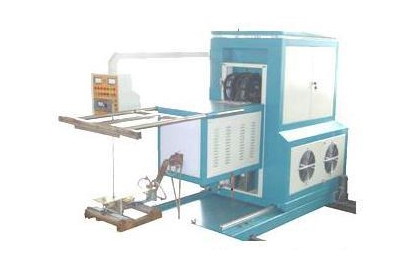Sales hot line ( 24 hours service):+86 13015583380
E-Mail: firstfurnace@gmail.com
whatsapp:+86 13015583380
Adress: Luoxin Industrial Park, Luoyang, HenanLarge diameter steel pipe quen
Piston rod quenching and tempe
Grinding rod quenching and tem
High frequency induction heate
Quenching equipment for machin
Round steel end heating furnac
Steel pipe heat treatment prod
Square steel quenching and tem
Sucker rod quenching and tempe
Thickened petroleum steel pipe
Round steel quenching and temp
Steel pipe quenching and tempe
Steel plate quenching and temp
Induction Hardening Machine&nb
Flywheel ring gear high freque
Process points of heat treatment of large diameter springs with high frequency hardening machine
Large-diameter springs are made of hot coils. As springs for large valves, they have to withstand repeated elongation and compression during operation. Therefore, they should have excellent elasticity and fatigue strength. The failure modes of the spring are mainly fatigue fracture and Stress relaxation, and about 90% of springs fail due to fatigue fracture. According to its service conditions, 50CrVA spring steel with good hardenability, small deformation and good mechanical properties must be selected. After quenching + medium temperature tempering by high-frequency hardening machine, it can fully meet its work needs. Today, I will tell you about its high-frequency heat treatment process.
(1) Heat treatment process
a. The spring before rolling is made of abrasive materials, and the heating of the spring is carried out by a high-frequency hardening machine. It has the characteristics of short heating time and fine austenite grains. Due to the fine austenite grains, the material body is increased. The number of structure grains and the area of grain boundaries reduce stress concentration and increase the resistance of dislocation movement. The heating temperature is (900±10)℃. At this time, the material’s high temperature strength and good plasticity are used to make the rolling easy. However, the heating temperature should not be too high or the holding time is too long, otherwise the material will overheat or surface Oxidation and decarburization may even result in overburning and scrapping.
b. Quenching + tempering at medium temperature. Heating is carried out on the high-frequency hardening machine, the heating temperature is 850-880℃, the heat preservation coefficient is calculated at 1.5min/mm, based on the through firing, the cooling medium has an important influence on the hardness and performance of the spring, and oil cooling can be selected. Meet its process requirements.
c. Tempering is also carried out by high-frequency quenching machine. According to the requirements of hardness, perpendicularity and gap, use special tempering fixture to fix and place it correctly. The heating temperature is 400-440℃, and the water is cooled after heat preservation. The tempering temperature of general springs is generally 400-500℃, and higher fatigue strength can be obtained after tempering.
(2) Analysis and implementation points of heat treatment process of spring
① Because 50CrVA steel has many alloying elements, the hardenability of the steel is improved. Chromium is a strong carbide element, and their carbides exist near the grain boundary, so it can effectively prevent the growth of grains, so it is appropriately improved Quenching temperature and prolonging the holding time will not cause the growth of crystal grains.
②In the heating process of hot coil springs, attention should be paid to the relationship between surface decarburization and quenching heating temperature and time. Practice has shown that high quenching temperature and long heating time will cause decarburization to increase. Therefore, when high-frequency quenching machine is used for heating, the process parameters should be strictly controlled. In addition, coating or packing protection heating can also be used to reduce the oxidation and decarburization of the surface. There are literatures that the surface decarburization of the spring reduces its service life, and it is easy to become a source of fatigue cracks.
③Medium temperature tempering of the spring is to obtain the required microstructure and performance. Considering that 50CrVA steel is a material that produces second temper brittleness, it must be cooled quickly (oil or water cooling) after tempering to prevent temper brittleness (causing Its impact toughness is reduced), and it can cause residual compressive stress on the surface, which is beneficial to improve the fatigue strength. Usually, water cooling is used instead of oil cooling. The structure after tempering is tempered troostite with a hardness of 40-46HRC. It has good elasticity and sufficient strength and toughness. In addition, if the tempering time is too short, the uniform structure and performance cannot be obtained, and the performance is not improved if the time is too long. Therefore, a process test should be carried out to determine a reasonable time.

Iron induction furnace

Aluminum melting furnace

Copper melting furnace

Small steel melting furnace

Small induction melting furnace

Induction iron furnace

3T intermediate frequency iron melting f

0.25T Intermediate Frequency Furnace

0.5T Intermediate Frequency Furnace

Medium Frequency Furnace

2T Induction Melting Furnace

1T Induction Melting Furnace

500kg Induction Melting Furnace

250kg Induction Melting Furnace

Induction Melting Furnace

3 T Induction Melting Furnace

5T Induction Melting Furnace

1T One Belt Two Intermediate Frequency F

5T One Belt Two Intermediate Frequency F

3T One Belt Two Intermediate Frequency F

2T One Belt Two Intermediate Frequency F

5T Parallel Intermediate Frequency Furna

5T Intermediate Frequency Furnace

5T Series Intermediate Frequency Furnace

3T Series Intermediate Frequency Furnace

2T Series Intermediate Frequency Furnace

1T Series Intermediate Frequency Furnace

0.5T Series Intermediate Frequency Furna

0.25T Series Intermediate Frequency Furn

1T Parallel Intermediate Frequency Furna

2T Parallel Intermediate Frequency Furna

0.5T Parallel Intermediate Frequency Fur







